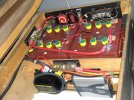I hope you find time to address this. You seem to be the electrical system guru.
The van owner said I could take out the passenger seat. There's already a heater under there that doesn't work. Hopefully that will get repaired. Once the seat, which sits on those white metal pedestals, is gone, I'd like to put 2 lithium batteries and my chest style refrigerator there. A YouTube expediter says his 2 batteries will run his fridge for days between recharging them.
For next summer, one of those Cool Breeze AC units with 2 batteries. I partition off the space behind my bed with curtains so I'll be cooling a small space.
Anyway, I don't know much about electrical stuff. What do I need to do to install those house batteries? What kind of cabling from the van battery? I know the terms in series and in parallel, but really, the terms are all I know.
I'd like to avoid lugging a generator around but I guess I would if I had to. Suppose I could put it up front by the fridge and batteries.
I'd appreciate any guidance you could give.
The van owner said I could take out the passenger seat. There's already a heater under there that doesn't work. Hopefully that will get repaired. Once the seat, which sits on those white metal pedestals, is gone, I'd like to put 2 lithium batteries and my chest style refrigerator there. A YouTube expediter says his 2 batteries will run his fridge for days between recharging them.
For next summer, one of those Cool Breeze AC units with 2 batteries. I partition off the space behind my bed with curtains so I'll be cooling a small space.
Anyway, I don't know much about electrical stuff. What do I need to do to install those house batteries? What kind of cabling from the van battery? I know the terms in series and in parallel, but really, the terms are all I know.
I'd like to avoid lugging a generator around but I guess I would if I had to. Suppose I could put it up front by the fridge and batteries.
I'd appreciate any guidance you could give.


